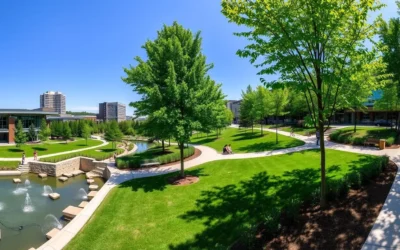✓ Accommodations ✓ Flights ✓ Rental Cars
You might be surprised by the linguistic diversity in North Carolina. As a state with a significant population, it ranks ninth in the United States. Many people immigrate to the state, bringing their language and culture with them.
While English is the official language, many other languages are spoken throughout the state. An estimated 11.8% of residents aged five and older speak a non-English language at home, which translates to around 1.2 million residents in households where a language other than English is spoken.
This diversity has a significant impact on the state’s population and economy. Understanding the languages spoken in North Carolina is crucial for businesses, healthcare providers, and government agencies serving the diverse communities.
The Linguistic Landscape of North Carolina
As you explore North Carolina, you’ll discover a rich tapestry of languages spoken across the state. The state’s linguistic diversity is a reflection of its cultural heritage and the various communities that reside there.
English as the Official Language
English is the official language of North Carolina, established through legislation to ensure it remains the primary language for government operations. This designation reflects the fact that the vast majority of residents speak English. However, it’s not the only language spoken in the state.

Language Diversity Statistics
Approximately 11.8% of North Carolina residents aged five and older speak a non-English language at home. This translates to around 1.2 million residents living in households where languages other than English are regularly spoken. While many of these individuals are bilingual, about 4.84% of the population has limited English proficiency (LEP), relying on their primary language for communication.
The language diversity in North Carolina is a result of various factors, including immigration patterns that have shaped the state’s linguistic composition over generations. Understanding these statistics is crucial for businesses, healthcare providers, and government agencies to effectively communicate with all North Carolina residents.
Immigration History and Language Evolution in North Carolina
As you explore the history of North Carolina, you’ll discover how immigration has impacted the languages spoken in the state. The region’s linguistic landscape has been shaped by various immigration waves throughout its history.
Indigenous Languages Before European Settlement
Before European settlers arrived, an estimated 50,000 indigenous people lived in the region, speaking their own languages and dialects. This diverse linguistic heritage laid the groundwork for the language evolution that followed.
European Immigration Waves
The arrival of European settlers in the 1650s marked the beginning of significant changes in the linguistic landscape. Initially, English was the dominant language, but it was soon followed by the influence of other European languages, including German, French, and Scottish. The forced migration of enslaved Africans also contributed to the linguistic diversity, introducing various African languages and dialects.
| Immigration Wave | Primary Languages Introduced | Impact on North Carolina’s Linguistic Landscape |
|---|---|---|
| Indigenous People | Various Indigenous Languages | Initial linguistic diversity |
| European Settlement (1650s) | English, German, French, Scottish | Introduction of European languages |
| African Migration | Various African Languages | Contribution to unique speech patterns and vocabulary |
Modern Immigration Patterns
In recent decades, North Carolina has experienced significant immigration from various countries, including Mexico, the Philippines, India, Vietnam, and China. This has led to a diverse array of languages being spoken in the state, with Spanish influx of people from the Middle East has also contributed to the linguistic diversity.
influx of people from the Middle East has also contributed to the linguistic diversity.
Today, the state’s population reflects a broad mix of cultures and languages, with English remaining the official and dominant language. The immigration history of North Carolina explains why the state hosts such a diverse array of languages.
North Carolina, United States: Official and widely spoken languages
As you explore the linguistic landscape of North Carolina, you’ll discover the complexities of language diversity. The state’s population is a mosaic of languages, with English being the official language. However, the presence of other languages is significant, and understanding this diversity is crucial for effective communication and service provision.
Limited English Proficiency in North Carolina
Approximately 4.84% of North Carolina’s population has limited English proficiency (LEP), relying on their primary language for communication. This demographic requires special consideration to ensure they have access to essential services.
Language Access Services and Requirements
To bridge the communication gap, federal civil rights laws mandate that businesses and agencies receiving federal funding provide language access services. This includes interpreters and translated materials to assist individuals with LEP. For instance, hospitals must translate vital documents into the 15 most common languages in their service areas.

| Service Area | Language Access Requirement |
|---|---|
| Hospitals | Translate vital documents into the 15 most common languages |
| Businesses and Agencies | Provide interpreters and translated materials |
Impact of Linguistic Diversity on Communities
The linguistic diversity in North Carolina has a significant impact on communities, affecting areas such as education, healthcare, and social integration. Schools must develop strategies to support students from non-English speaking households, while communities with significant linguistic diversity often develop unique cultural characteristics.
To address the challenges and opportunities presented by linguistic diversity, it is essential to understand the needs of the population and provide adequate language access services. This not only ensures equal access to services but also enriches the state’s cultural fabric.
Top 10 Non-English Languages in North Carolina
You might be surprised at the array of languages spoken in North Carolina, with a significant number of residents communicating in languages other than English. The state’s linguistic diversity is a reflection of its cultural heritage and the various immigrant communities that have settled there.
Spanish
Spanish is the most widely spoken non-English language in North Carolina, with approximately 736,886 speakers, representing about 7.53% of the population. This significant presence is due to the large Hispanic community in the state.
Chinese (Cantonese and Mandarin)
Chinese, encompassing both Cantonese and Mandarin, is the second most common non-English language, with 37,320 speakers, making up about 0.38% of North Carolina’s population.
French (Including Cajun)
French, including Cajun varieties, ranks third with around 29,939 speakers, or 0.31% of the population. This reflects both historical European immigration and more recent arrivals.
Arabic
Arabic follows closely in fourth place with 28,183 speakers, representing about 0.29% of the population. This indicates a growing community from the Middle East and North Africa.
Vietnamese
Vietnamese is the fifth most common language, not including English, with an estimated 24,305 speakers, or nearly 0.25% of the population. This reflects immigration patterns following the Vietnam War and subsequent family reunification.
German
German maintains a significant presence in sixth place with about 21,300 speakers, or 0.22% of the population, a legacy of historical European immigration waves.
Hindi
Hindi comes in seventh place with 19,792 speakers, representing about 0.20% of the population. This highlights the influence of Indian culture in the state.
Telugu
Telugu, a language primarily spoken in southern India, is the eighth most common non-English language, with 16,684 speakers, or just over 0.17% of the population.
Korean
Korean is just behind Telugu, with 16,608 speakers, representing about 0.17% of North Carolina’s population.
Tagalog (Including Filipino)
Rounding out the top 10 is Tagalog (including Filipino), with around 14,292 speakers, or nearly 0.15% of the population. This reflects the presence of Filipino communities in the state.
The top 10 non-English languages in North Carolina reflect the state’s diverse cultural landscape and its role as a destination for various immigrant populations. Understanding these languages is crucial for providing adequate services and ensuring that all residents have access to the information they need.
The Impact of Language Diversity on North Carolina’s Economy and Culture
North Carolina’s linguistic diversity is a significant factor in shaping the state’s economy and cultural identity. The presence of multiple languages has created a unique environment where businesses can thrive by catering to diverse linguistic groups.
Economic Opportunities
The linguistic diversity in North Carolina creates significant business and economic opportunities. Companies that offer multilingual services can tap into broader market segments, reaching the approximately 1.2 million residents who speak languages other than English at home. The demand for translation and interpretation services has created a growing industry, providing jobs and economic benefits. Multilingual employees are valuable assets in various sectors, improving customer service and expanding market reach.
- Businesses can expand their market by providing translations and localized content.
- The demand for translation services has created a new industry, generating jobs and economic benefits.
Cultural Enrichment
The cultural enrichment derived from linguistic diversity is evident in North Carolina’s vibrant food scene, arts, festivals, and community events that celebrate the state’s multicultural heritage. Communities built around shared languages serve as support networks for new immigrants, aiding their integration while preserving cultural traditions.

- Cultural events and festivals celebrate the state’s multicultural heritage.
- Language-based communities support new immigrants in their integration journey.
Conclusion
Our journey through the languages of North Carolina has revealed a complex and dynamic linguistic landscape. The state’s linguistic diversity is shaped by its immigration history and continues to impact its cultural and economic development. With approximately 4.84% of the population having limited English proficiency, there is a clear need for language access services.
As you navigate this landscape, whether you’re a business owner or service provider, embracing the state’s multilingual reality can enrich your personal journey and professional success. Now is the perfect time to future-proof your business by embracing translation and localization, allowing you to serve all communities effectively and inclusively.
The above is subject to change.
Check back often to TRAVEL.COM for the latest travel tips and deals.






